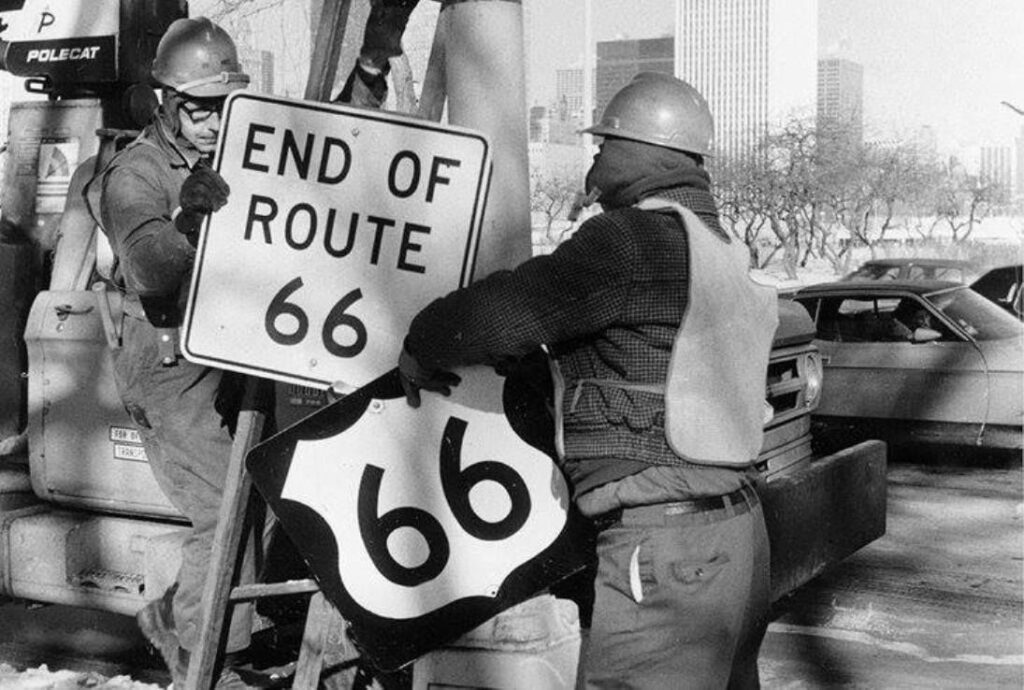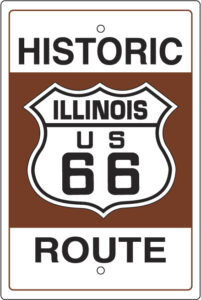This article from CamperSmarts.com winds back the clock with an in-depth examination of the very roots of the Mother Road, from trail to road to popular route to historic icon of Americana.
Learn about this historic highway and why Route 66 is an American treasure worth preserving.
Read Route 66: The History and Adventures of the Mother Road (this links to an external site that is not affiliated with the Association).
Route 66 Overview
The Mother Road
Route 66 is probably the most well known road in this country, if not the world. Created in 1926, along with the rest of the federal highway system, it existed until 1985 when it was formally decommissioned and replaced by interstate highways.

Portions actually disappeared from the various states prior to the formal decommissioning – for example, Illinois removed the last of its US 66 signage in early 1977 (as seen in this iconic image). Official roadmaps ceased to identify Route 66 in the mid-1970s, with the official 1975 map showing US 66 and I-55 sharing a roadbed (some of this sharing actually started in the early 1960s). Illinois’ official 1977 map no longer contained any references to US 66.
In the time between, it earned a home for itself in the hearts and memories of people across the country. And that place can never be taken by an interstate highway. The road passed through eight states: Illinois, Missouri, Kansas, Oklahoma, Texas, New Mexico, Arizona and California.
It Began in Illinois

Route 66 began in Chicago in 1926, at the intersection of Jackson Boulevard and Michigan Avenue (the marker for the start is now located on Adams, as Jackson is now an east-bound one way street). Originally, the route followed Illinois State 4 from Chicago to East St. Louis, although the section from Springfield south was relocated in 1930 to roughly the path of the current Interstate 55.
Illinois was the first state to have its section completely hard surfaced. And it was the first state to replace the old road with the interstate.
Post-Decommissioning
Formation of Associations
With the removal of federal Route 66 highway signs and the lack of any designation on maps, many Americans thought the road no longer existed. In government terms, this was true. But while parts of the old road had disappeared under the interstate’s path, most of its 2,448 miles of pavement still existed and could be driven – if one knew where to look! By 1984, when Interstate 40 bypassed the last stretch of Route 66 in Arizona, a movement was already developing to resurrect the old road, put up new road signs, and restore it to the maps and atlases of the world. It might not be the great commercial artery that it once was, but it could still be a road – a road that people could use to enjoy a slower and more relaxed way of travel. The first state Route 66 association was formed in February 1987. On March 5, 1989, 15 people met in Pontiac. From there a core group of Illinois Route 66 fans began meeting to form an association in Illinois. That association was formally established in October 1989 in Dwight, Illinois. At that founding meeting, the association elected officers and adopted bylaws to govern its operations.
Historic Illinois Route 66

One of our association’s primary aims is to convince federal and state governments that Route 66 should receive special designation as a historic or scenic highway. In the Spring of 1995 IDOT put up historic signs along Route 66 in Illinois, complete with arrows. We hope this will lead to the establishment of visitors centers, museums, roadside parks and other sites dedicated to the memory and enjoyment of Route 66. There is a Route 66 association in each state along the way now working toward these goals. These associations work independently on state projects, but they work collectively on national efforts. The more members we have who will work for these goals, the better our chances are of achieving them.